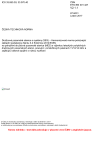ČSN ETSI EN 301 427 V2.1.1 (876031)
Družicové pozemské stanice a systémy (SES) - Harmonizovaná norma pokrývající základní požadavky článku 3.2 Směrnice 2014/53/EU na pohyblivé družicové pozemské stanice (MES) s výjimkou leteckých pohyblivých družicových pozemských stanic, pracující v kmitočtových pásmech 11/12/14 GHz a zajišťující datové spojení s nízkou rychlostí
Anotace obsahu normy
The present document applies to Mobile Earth Stations (MES), except aeronautical mobile earth stations, which have the following characteristics:
- The MES are operating in one or more frequency ranges of the Fixed Satellite Service (FSS):
- 10,70 GHz to 11,70 GHz (space to earth);
- 12,50 GHz to 12,75 GHz (space to earth);
- 14,00 GHz to 14,25 GHz (earth to space).
Because the transmissions from the MES to the Satellite in the 14,00 GHz to 14,25 GHz band fall under a sec-ondary allocation, the transmissions should not cause harmful interference to primary services (e.g. the Fixed Satellite Service (FSS)) and at the same time cannot claim protection from harmful interference from those ser-vices.
- The MES may be either:
- a Land Mobile Earth Station (LMES) radio equipment; and/or
- a Maritime Mobile Earth Station (MMES) radio equipment not providing those distress and safety functions required by the International Maritime Organization (IMO).
- These LMESs could be either vehicle mounted or portable equipment.
- These MMESs are installable equipment on ships.
- The MES could consist of a number of modules including a keyboard interface to the user.
- The MES use linear polarization.
- The MES operate through a geostationary satellite at least 3° away from any other geostationary satellite operating in the same frequency band and covering the same area.
- The antenna of the MES may be omnidirectional or directional with a means of tracking the satellite.
- The MES are operating as part of a satellite network used for the distribution and/or exchange of infor-mation between users.
- The MES are controlled and monitored by a Network Control Facility (NCF). The NCF is outside the scope of the present document.
The present document applies to the MES with its ancillary equipment and its various terrestrial ports, and when operated within the boundary limits of the operational environmental profile declared by the manufacturer.
The present document is intended to cover the provisions of Directive 2014/53/EU [3] (RE Directive) article 3.2, which states that ". radio equipment shall be so constructed that it both effectively uses and supports the effi-cient use of radio spectrum in order to avoid harmful interference".
In addition to the present document, other ENs that specify technical requirements in respect of essential re-quirements under other parts of article 3 of the RE Directive [3] may apply to equipment within the scope of the present document.
NOTE: A list of such ENs is included on the ETSI web site.
| Označení | ČSN ETSI EN 301 427 V2.1.1 (876031) |
|---|---|
| Katalogové číslo | 500970 |
| Cena | 550 Kč550 |
| Datum schválení | 1. 1. 2017 |
| Datum účinnosti | 1. 2. 2017 |
| Jazyk | angličtina (obsahuje pouze anglický originál) |
| Počet stran | 52 stran formátu A4 |
| EAN kód | 8596135009701 |
| Dostupnost | skladem (tisk na počkání) |


